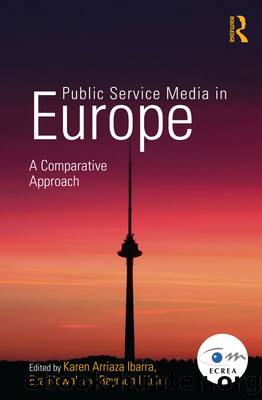Public Service Media in Europe: A Comparative Approach by Karen Arriaza Ibarra Eva Nowak Raymond Kuhn

Author:Karen Arriaza Ibarra, Eva Nowak, Raymond Kuhn [Karen Arriaza Ibarra, Eva Nowak, Raymond Kuhn]
Language: eng
Format: epub
Tags: Nonfiction, Social & Cultural Studies, Social Science
ISBN: 9781317524557
Publisher: Taylor and Francis
Published: 2015-07-16T04:00:00+00:00
EBU research has found that how PSM are funded has little impact on the organizationsâ market shares or programming output, while the most important factor seems to be absolute income (EBU 2012, p. 4). The argument of this chapter is that the funding mechanisms of PSM should be contextualized within a dynamic relationship between PSM autonomy and dependency (regarding various actors and resources) and situated in a given cultural and geographical context. PSM do not operate in a cultural vacuum; hence the funding mechanisms do not depend only on technocratic conditions, but also on cultural precepts, including collective perceptions, attitudes towards PSM and behaviour. In other words, the actual funding mechanisms of PSM are strongly shaped by cultural values and practices, including political culture. Picard observes that differences in the funding of PSM are evident between northern and southern European nations, between nations influenced by Anglo, Germanic and Latin cultures, among nations with stronger social welfare orientation and others, and among nations in which PSM existed from the inception of broadcasting and those in which they developed out of State broadcasting companies (Picard 2006, p. 185).
Moreover, global media and policy flows generate some commonalities and interdependencies. As noted above, PSM were increasingly affected by competition law and State aid rules of the EC treaty (Bardoel and Vochteloo 2012), as well as by the global financial crisis and its impact on public finances and advertising markets (EBU 2013). It is worth mentioning though that PSM still occupy a central position in many EU countries with regard to both audience share and total revenue. In 2012 Germany and the United Kingdom were the two countries with by far the highest levels of funding in the EU, with â¬8.9 billion and â¬7.9 billion respectively; they were followed by France and Italy, which allocated â¬3.8 billion and â¬2.6 billion to PSM (EBU 2013, p. 11). The sharpest funding cuts were experienced by PSM in Spain, Portugal, Poland and Slovakia (EBU 2013, p. 11). The following sections focus on an analysis of various PSM funding models found in six EU Member States, including northern, southern and eastern as well as large, middle-size and small countries: France, Germany, Italy, Poland, Spain and Sweden.
Funding Mechanisms: Between Pluralism and Licence Fee Option
Long-standing practice in various European countries has contributed to a broad acceptance (not without controversy) of various forms of funding including a flat broadcasting licence fee, taxation, State subsidies, subscription fees, advertising and sponsorship revenue, specialized pay-per-view or on-demand services, the sale of related products such as books, videos and films, and the exploitation of PSMâs audiovisual archives (Council of Europe 2009). Four components of this funding pluralism have become especially important in recent years: Licence fee, advertising, pay TV and State subsidies.
In 2011 EBU public service members on average received 60 per cent of their financing from licence fees, 29 per cent from commercial income such as advertising and sponsorship and 10 per cent from State grants and subsidies (EBU 2012). In 2012 licence fee revenues composed 64.
Download
This site does not store any files on its server. We only index and link to content provided by other sites. Please contact the content providers to delete copyright contents if any and email us, we'll remove relevant links or contents immediately.
| Automotive | Engineering |
| Transportation |
Whiskies Galore by Ian Buxton(41937)
Introduction to Aircraft Design (Cambridge Aerospace Series) by John P. Fielding(33092)
Small Unmanned Fixed-wing Aircraft Design by Andrew J. Keane Andras Sobester James P. Scanlan & András Sóbester & James P. Scanlan(32764)
Craft Beer for the Homebrewer by Michael Agnew(18196)
Turbulence by E. J. Noyes(7977)
The Complete Stick Figure Physics Tutorials by Allen Sarah(7338)
Kaplan MCAT General Chemistry Review by Kaplan(6899)
The Thirst by Nesbo Jo(6877)
Bad Blood by John Carreyrou(6581)
Modelling of Convective Heat and Mass Transfer in Rotating Flows by Igor V. Shevchuk(6406)
Learning SQL by Alan Beaulieu(6237)
Weapons of Math Destruction by Cathy O'Neil(6214)
Man-made Catastrophes and Risk Information Concealment by Dmitry Chernov & Didier Sornette(5956)
Digital Minimalism by Cal Newport;(5704)
Life 3.0: Being Human in the Age of Artificial Intelligence by Tegmark Max(5514)
iGen by Jean M. Twenge(5385)
Secrets of Antigravity Propulsion: Tesla, UFOs, and Classified Aerospace Technology by Ph.D. Paul A. Laviolette(5333)
Design of Trajectory Optimization Approach for Space Maneuver Vehicle Skip Entry Problems by Runqi Chai & Al Savvaris & Antonios Tsourdos & Senchun Chai(5037)
Pale Blue Dot by Carl Sagan(4953)
